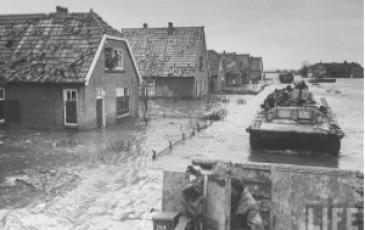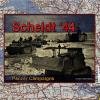1001_02_Rijkevorsel_Bridgehead "Crossing the Border" - PzC 24 Scheldt '44

 1 - 0 - 3
1 - 0 - 3

| Rating: | 7.38 (6) |
| Games Played: | 4 |
| SM: | 4 |
| Turns: | 44 |
| Type: | Stock |
| First Side: | Allies |
| Second Side: | Axis |
Crossing the Border, 1 October 1944: After the Failure of Operation Market Garden, Field Marshall Bernard Montgomery issued a new directive to the 21st Army Group on the 27th. The 1st Army was to continue operating with "all available strength" out of the Nijmegen salient toward Germany. Meanwhile, the 1st Canadian Army, already strung out from Calais to Turnhout, was given additional responsibilities. It was to provide a force to cover the German pocket at Dunkerque (though the capture of Dunkerque was no longer a priority), clear the Scheldt estuary, and relieve pressure on the Nijmegen salient with an attack to Tilburg. The new directive required I Corps to make simultaneous, divergent attacks to the northeast and northwest, violating the basic military tenant of concentration of force.
After days of hard fighting at Rijkevorsel and Merxplas, the 1st Polish Armoured and 49th (West Riding) Divisions had established a bridgehead on the northern bank of the Turnhout canal near the Belgian-Dutch border and I Corps was ready to begin its offensive in earnest on October 1st. The Polish armor would lead the northeasterly attack toward Tilburg, advancing through Zondereigen, Baarle-Nassau, and Alphen. Meanwhile, the 5th and 6th Canadian Infantry Brigades, having failed to establish a bridgehead of their own, would attack west out of the Polish bridgehead to clear the Turnhout Canal. On the second day, the 4th Canadian Infantry Brigade, supported by and improvised force of Belgian resistance fighters, would attack out of Antwerp with the goal of reaching Woensdrecht and cutting off the Zuid-Beveland isthmus from the mainland. 49th (West Riding) would go into action on the 3rd, attacking toward Tilburg on the Poles' right through Poppel and Goirle. A brigade-sized formation labelled "Bobforce," composed of anti-tank and "jobless" anti-aircraft personnel, would attempt to cover the gap that would necessarily open between the Canadians and Poles as they attacked in opposite directions.
I Corps was opposed by three badly-off German coastal divisions. 711. I.D. and 346. I.D. had been badly mauled during the retreat through France and Belgium. With much of its infantry strength detached, 719. I.D. had become a "pawn shop" of military miscellany - Luftwaffe recruits, "stomach" troops, and Dutch SS. Despite the apparent weakness of the German position, I Corps was in for a difficult fight. Crocker and his men had been issued a difficult task, perhaps rendered impossible by nature - the weather was firmly on Germany's side...
[Size: Medium]
After days of hard fighting at Rijkevorsel and Merxplas, the 1st Polish Armoured and 49th (West Riding) Divisions had established a bridgehead on the northern bank of the Turnhout canal near the Belgian-Dutch border and I Corps was ready to begin its offensive in earnest on October 1st. The Polish armor would lead the northeasterly attack toward Tilburg, advancing through Zondereigen, Baarle-Nassau, and Alphen. Meanwhile, the 5th and 6th Canadian Infantry Brigades, having failed to establish a bridgehead of their own, would attack west out of the Polish bridgehead to clear the Turnhout Canal. On the second day, the 4th Canadian Infantry Brigade, supported by and improvised force of Belgian resistance fighters, would attack out of Antwerp with the goal of reaching Woensdrecht and cutting off the Zuid-Beveland isthmus from the mainland. 49th (West Riding) would go into action on the 3rd, attacking toward Tilburg on the Poles' right through Poppel and Goirle. A brigade-sized formation labelled "Bobforce," composed of anti-tank and "jobless" anti-aircraft personnel, would attempt to cover the gap that would necessarily open between the Canadians and Poles as they attacked in opposite directions.
I Corps was opposed by three badly-off German coastal divisions. 711. I.D. and 346. I.D. had been badly mauled during the retreat through France and Belgium. With much of its infantry strength detached, 719. I.D. had become a "pawn shop" of military miscellany - Luftwaffe recruits, "stomach" troops, and Dutch SS. Despite the apparent weakness of the German position, I Corps was in for a difficult fight. Crocker and his men had been issued a difficult task, perhaps rendered impossible by nature - the weather was firmly on Germany's side...
[Size: Medium]
| Player Voting Stats | ||
|---|---|---|
| Member | Balance | Enjoyment |
| Well Balanced | 8 | |
| Slightly Pro Axis | 6 | |
| Moderately Pro Axis | 6 | |
| Well Balanced | 8 | |
| Well Balanced | 5 | |
| Gaming Records | |||||||||
|---|---|---|---|---|---|---|---|---|---|
| 1st Side Player | 2nd Side Player | Result | Score | ||||||
 |
Sir John Cope | vs. | Bioman |  |
Axis Major Victory | 72 | 8 | ||
 |
PK Powers | vs. | Landser34 |  |
Allies Minor Victory | 56 | 24 | ||
 |
larsonney | vs. | Green |  |
Axis Major Victory | 72 | 8 | ||
 |
majorZero | vs. | Sandmd |  |
Axis Major Victory | 72 | 8 | ||
Engaging fighting retreat type scenario which is largely infantry vs infantry focused.
Close run affair, low quality troops and difficult terrain can be frustrating
didnt get win until last couple of turns
A delaying action from the Axis point of view. Forces are hopelessly unequal: the Axis troops a ragged collection of weak regulars and odds and ends. Time and especially the weather are the Germans' strongest weapons.
Very boring scenario. Allies have poor units and poor movement ratings. Germans too many reinforcements.

























